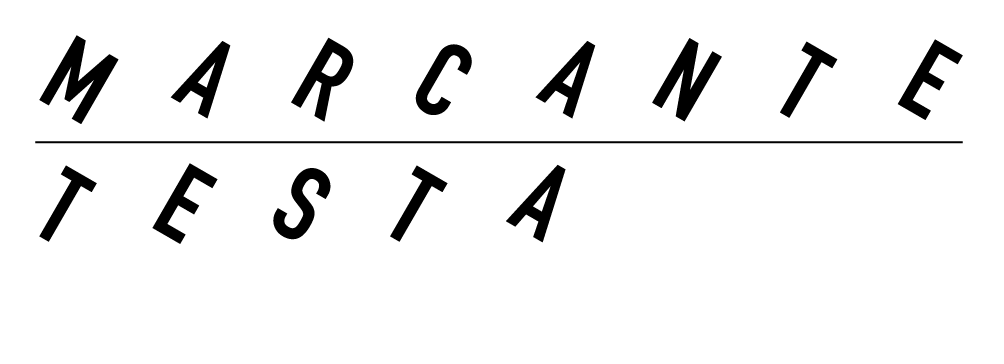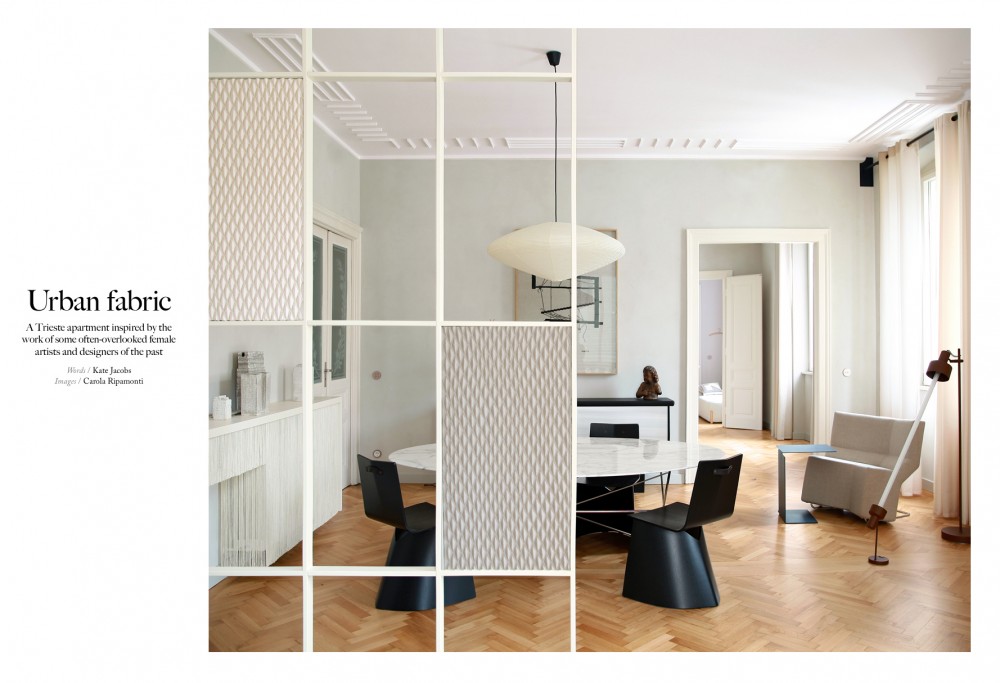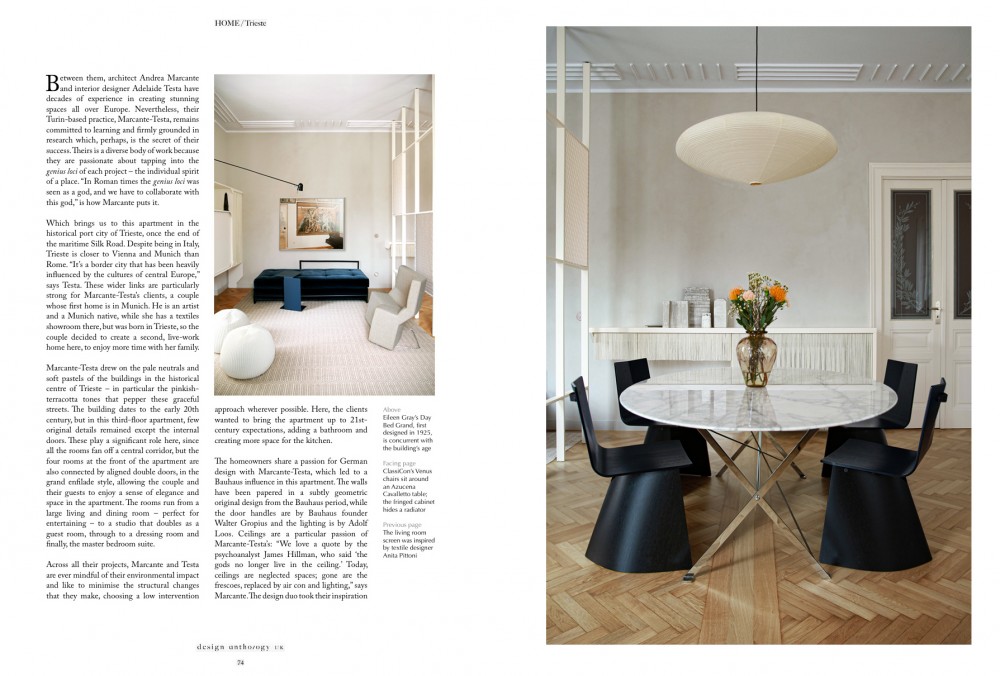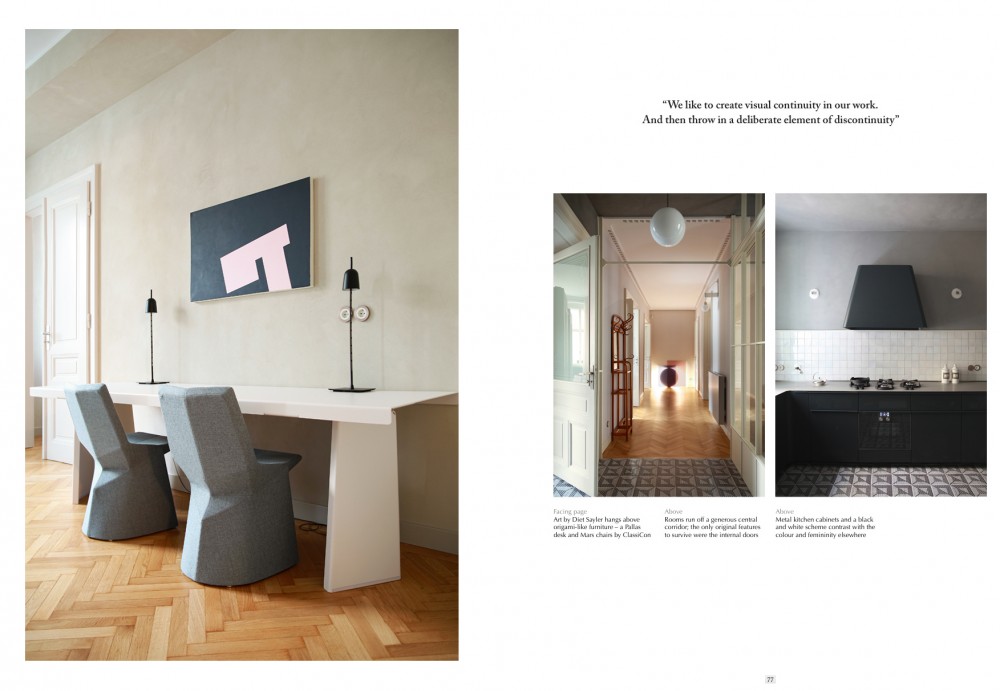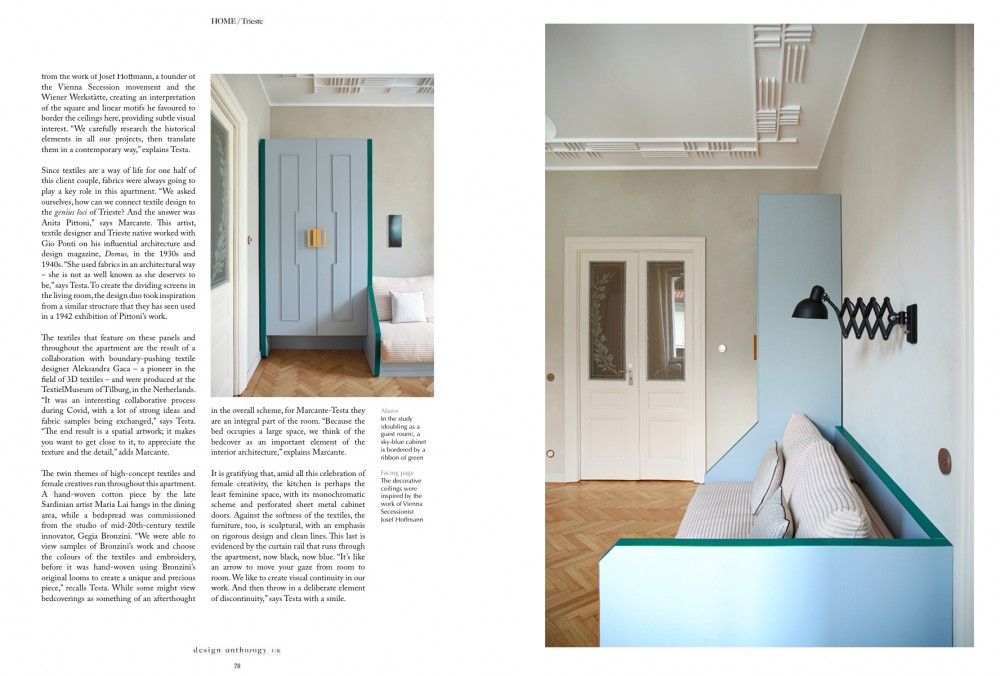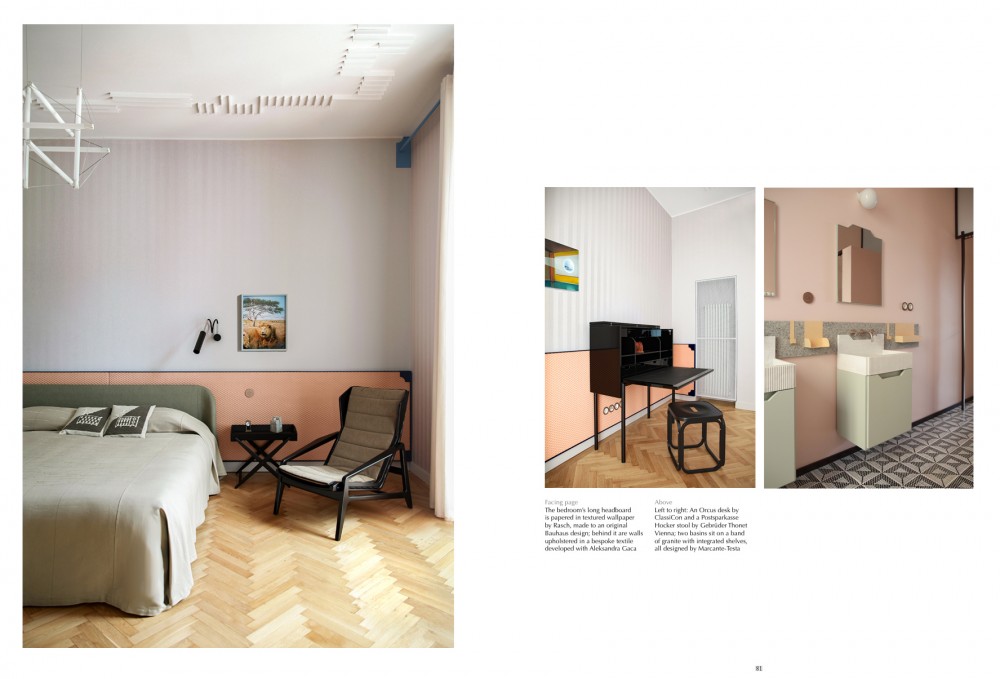URBAN FABRIC
Words by Kate Jacobs
Photos by Carola Ripamonti
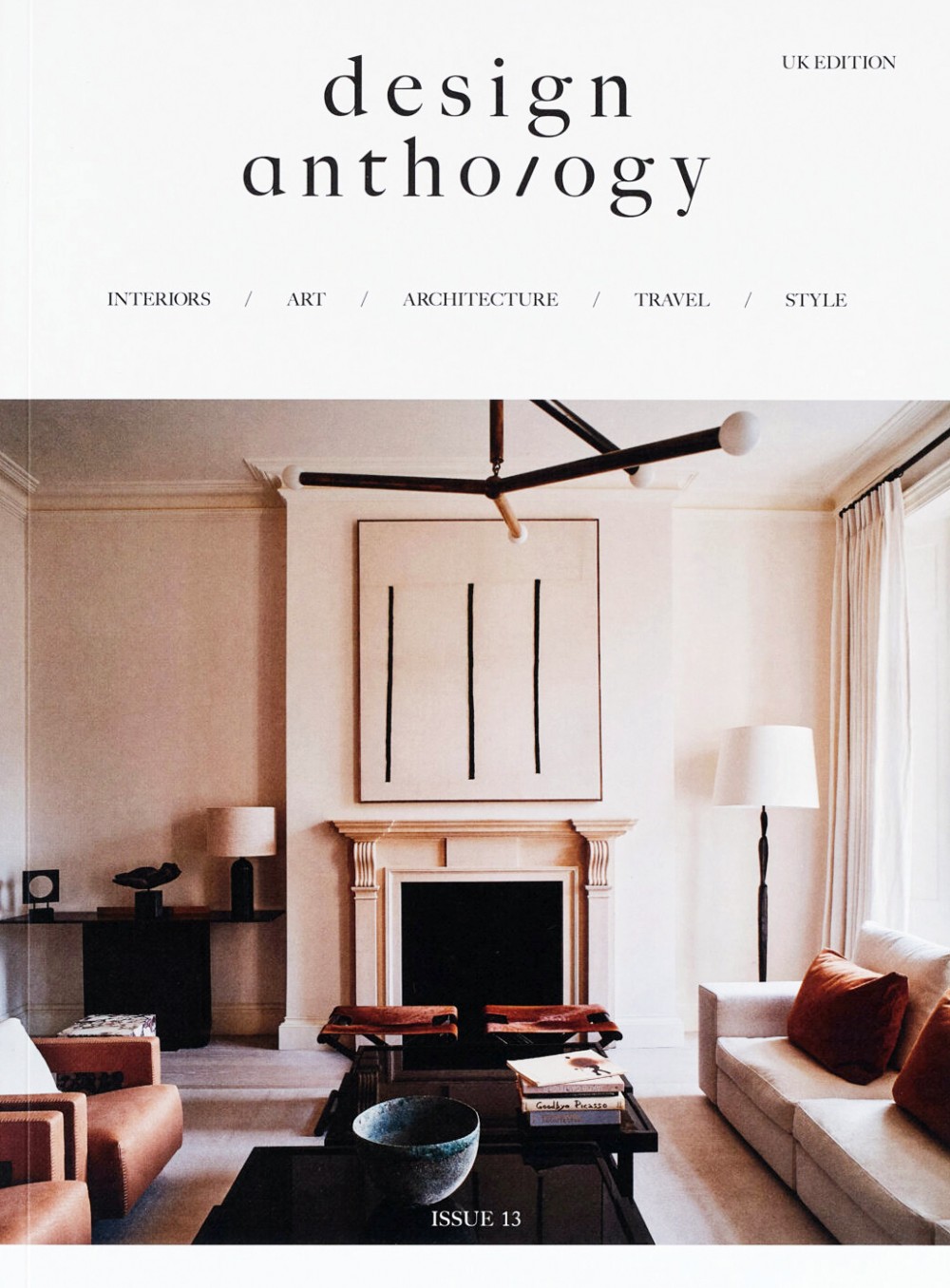
Between them, architect Andrea Marcante and interior designer Adelaide Testa have decades of experience in creating stunning spaces all over Europe.
Nevertheless, their Turin-based practice, Marcante-Testa, remains committed to learning and firmly grounded in research which, perhaps, is the secret of their success.
Theirs is a diverse body of work because they are passionate about tapping into the genius loci of each project –the individual spirit of a place. “In Roman times the genius loci was seen as a god, and we have to collaborate with this god”, is how Marcante puts it.
Which brings us to this apartment in the historical port city of Trieste, once the end of the maritime Silk Road. Despite being in Italy, Trieste is closer to Vienna and Munich than Rome. “It’s a border city that has been heavily influenced by the cultures of central Europe,” says Testa. These wider links are particularly strong for Marcante-Testa’s clients, a couple whose first home is in Munich. He is an artist and Munich native, while she has a textile showroom there, but was born in Trieste, so the couple decided to create a second, live-work home here, to enjoy more time with her family.
Marcante-Testa drew on the pale neutrals and soft pastels of the buildings in the historical centre of Trieste –in particulaer the pinkish-terracotta tones that pepper these graceful streets. The building dates to the early 20th century, but in this third-floor apartment, few original details remained except the internal doors. These play a significant role here, since all the rooms fan off a central corridor, but the four rooms at the front of the apartment are also connected by aligned double doors, in the grand enfilade style, allowing the couple and their guests to enjoy a sense of elegance and space in the apartment. The rooms fun from a large living and dining room –perfect for entertaining- to a studio that double sas a guest room, through to a dressing room and finally, the master bedroom suite.
Across all their projects, Marcante and Testa are ever mindful of their environmental impact and like to minimize the structural changes that they make, choosing a low intervention approach wherever possible. Here, the clients wanted to bring the apartment up to 21st-century expectations, adding a bathroom and creating more space for the kitchen.
The homeowners share a passion for German design with Marcante-Testa, which led to a Bauhaus influence in this apartment. The walls have been papered in a subtly geometric original design from the Bauhaus period, while the door handles are by Bauhaus founder Walter Gropius and the lighting is by Adolf Loos. Ceilings are a particular passion of Marcante-Testa’s: “We love a quote by the psychoanalyst James Hillman, who said ‘the gods no longer live in the ceiling.’ Today, ceilings are neglected spaces; gone are the frescoes, replaced by air con and lighting” says Marcante. The design duo took their inspiration from the work of Joseph Hoffmann, a founder of the Vienna Secession movement and the Wiener Werkstatte, creating an intepretation of the square and linear motifs he favoured to border the ceilings here, providing subtle visual interest. “We carefully research the historical elements in all our projects, then translate them in a contemporary way,” explains Testa.
Since textiles are a way of life for one half of this client couple, fabrics were always going to play a key role in this apartment. “We asked ourselves, how can we connect textile design to the genius loci of Trieste? And the answer was Anita Pittoni,” says Marcante. This artist, textile designer and Trieste native worked with Gio Ponti on his influential architecture and his design magazine, Domus, in the 1930s and 1940s. “she used fabrics in an architectural way – she is nota s well known as she deserves to be,” says Testa. To create the dividing screens in the living room, the design duo took inspiration from a similar structure that they has seen used in a 1942 exhibition of Pittoni’s work.
The textiles that feature on these panels and throughout the apartment are the result of a collaboration with boundary-pushing textile designer Aleksandra Gaca – a pioneer in the field of 3D textiles –and were produced at the TextielMuseum of Tilburg, in the Netherlands. “It was an interesting collaborative process during Covid, with a lot of strong ideas and fabric samples being exchanged,” says Testa. “The end resulti s a spatial artwork; it makes you wwant to get close to it, to appreciate the texture and the detail,” adds Marcante.
The twin themes of high-concept textiles and female creatives run troughout this apartment. A hand-woven cotton piece by the late Sardinian artist Maria Lai hangs in the dining area, while a bedspread was commissioned from the studio of mid-20th-century textile innovator, Gegia Bronzini. “We were able to view samples of Bronzini’s work and choose the colours of the textilesand embroidery, before it wash and-woven using Bronzini’s original looms to create a unique and precious piece,” recalls Testa. While some might view bedcoverings as something of an afterthought in the overall schemem for Marcante-Testa they are an integral part of the room. “Because the bed occupies a large space, we think of the bedcover as an important element of the interior architecture,” explains Marcante.
It is gratifying that, amid all this celebration of female creativity, the kitchen is perhaps the least feminine space, with its monochromatic scheme and perforated sheet metal cabinet doors. Against the softness of the textiles, the furniture, too is sculptural, with an emphasis on rigorous design and clean lines. This last is evidenced by the curtain rail that runs through the apartment, now black, now blue. “It’s like an arrow to move your gaze from room to room. We like to create visual continuity in our work. And then throw in a deliberate element of discontinuity,” says Testa with a smile.
